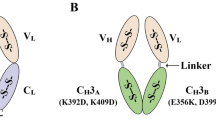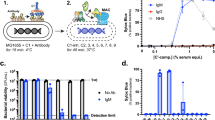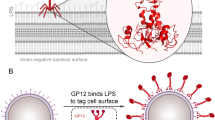Abstract
To target recombinant antibodies to the surface of Escherichia coli, we have fused single–chain variable domains to its peptidoglycan associated lipoprotein (PAL). The fusion protein was able to bind antigen and was tightly bound to the murein layer of the cell envelope. Antibody–PAL had little effect on cell growth and viability. In contrast, the expression of single chain antibody alone eventually resulted in cell lysis. Immunofluorescence studies on unfixed cells showed that functional antibodies were accessible at the surface of intact bacteria. This could provide a means of isolating single cells producing specific antibodies from libraries in E. coli by fluorescence assisted cell sorting (FACS). Pal fusions may also be of general interest for the presentation of proteins at the surface of E. coli as, for example, in the production of live vaccines.
This is a preview of subscription content, access via your institution
Access options
Subscribe to this journal
Receive 12 print issues and online access
$209.00 per year
only $17.42 per issue
Buy this article
- Purchase on Springer Link
- Instant access to full article PDF
Prices may be subject to local taxes which are calculated during checkout
Similar content being viewed by others
References
Better, M., Cheng, C.P., Robinson, R.R. and Horowitz, A.H. 1988. Escherichia coli secretion of an active chimeric antibody fragment. Science 240: 1041–1043.
Skerra, A. and Plückthun, A. 1988. Assembly of a functional immunoglobulin Fv fragment in Escherichia coli. Science 240: 1038–1041.
Charbit, A., Boulain, J.-C., Ryter, A. and Hofnung, M. 1986. Probing the topology of a bacterial membrane protein by genetic insertion of a foreign epitope; expression at the cell surface. EMBO J. 5: 3029–3037.
Agterberg, M., Adriaanse, H. and Tommassen, J. 1987. Use of the outer membrane protein, PhoE, as a carrier for the transport of a foreign antigenic determinant to the cell surface of Escherichia coli K–12. Gene 59: 145–150.
Freudl, R. 1989. Insertion of peptides into cell-exposed-areas of the Escherichia coli OmpA protein does not interfere with export and membrane assembly. Gene 82: 229–236.
Klauser, T., Pohlner, J. and Meyer, T.F. 1990. Extracellular transport of cholera toxin B subunit using Neisseria IgA protease β-domain: conformation-dependent outer membrane translocation. EMBO J. 9: 1991–1999.
Mizuno, T. and Kageyama, M. 1979. Isolation and characterization of major outer membrane proteins of Pseudomonas aeruginosa strain PAO with special reference to peptidpglycan-associated protein J. Biochem. 86: 979–989.
Mizuno, T. 1987. A novel peptidoglycan-associated lipoprotein found in the cell envelope of Pseudomonas aeruginosa and Escherichia coli. J. Biochem. 86: 991–1000.
Chen, R. and Henning, U. 1987. Nucleotide sequence of the gene for the peptidoglycan-associated lipoprotein of Escherichia coli. Eur. J. Biochem. 163: 73–77.
Breitling, F. and Little, M. 1986. Carboxy-terminal regions on the surface of tubulin and microtubules. Epitope locations of YOL1/34, DM1A and DM1B. J. Mol. Biol. 189: 367–370.
Lei, S.P., Lin, H.C., Wang, S.S., Callaway, J. and Wilcox, G. 1987. Characterization of the Erwinia carotova pelB gene and its product pectate lyase. J. Bacteriol. 169: 4379–4383.
Towbin, H., Staehelin, T. and Gordon, I. Electrophoretic transfer of protein from polyacrylamide gels to nitrocellulose sheets: procedures and some applications. Proc. Natl. Acad. Sci. USA 76: 4350–4354.
Laemmli, U.K. 1970. Cleavage of structural proteins during the assembly of the head of the bacteriophage T4. Nature 227: 680–685.
Ward, E.S., Güssow, D., Griffiths, A.D., Jones, P.T. and Winter, G. 1989. Binding activities of a repertoire of single immunoglobulin variable domains secreted from Escherichia coli. Nature 341: 544–546.
McCafferty, J., Griffiths, A.D., Winter, G. and Chiswell, D.J. 1990. Phage antibodies: filamentous phage displaying antibody variable domains. Nature 348: 552–554.
Breitling, F., Dübel, S., Seehaus, T., Klewinghaus, I. and Little, M. 1991. A surface expression vector for antibody screening. Gene. 104: 147–153.
Kang, A.S., Barbas, C.F., Janda, K.D., Benkovic, S.J. and Lerner, R.A. 1991. Linkage of recognition and replication functions by assembling combinatorial antibody Fab libraries along phage surfaces. Proc. Natl. Acad. Sci. USA 88: 4363–4366.
Charbit, A., Molla, A., Saurin, W. and Hofnung, M. 1988. Versatility of a vector for expressing foreign polypeptides at the surface of Gram-negative bacteria. Gene 70: 181–189.
Amit, A.G., Mariuzza, R.A., Phillips, S.E.V. and Poljak, R.J. 1986. Three dimensional structure of an antigen-antibody complex at 2.8 Å resolution. Science 233: 747–754.
Verhoeyen, M., Milstein, C. and Winter, G. 1988. eshaping human antibodies: grafting an antilysozyme activity. Science 239: 1534–1536.
Kilmartin, J.V., Wright, B. and Milstein, C. 1982. Rat monoclonal antitubulin antibodies derived by using a new nonsecreting rat cell line. J. Cell Biol. 93: 576–582.
Aman, E. and Brosius, J. 1985. “ATG vectors” for regulated high-level expression of cloned genes in Escherichia coli. Gene 40: 183–190.
Author information
Authors and Affiliations
Rights and permissions
About this article
Cite this article
Fuchs, P., Breitling, F., Dübel, S. et al. Targeting Recombinant Antibodies to the Surface of Escherichia coli: Fusion to a Peptidoglycan Associated Lipoprotein. Nat Biotechnol 9, 1369–1372 (1991). https://doi.org/10.1038/nbt1291-1369
Received:
Accepted:
Issue Date:
DOI: https://doi.org/10.1038/nbt1291-1369
This article is cited by
-
Screening individual hybridomas by microengraving to discover monoclonal antibodies
Nature Protocols (2009)
-
Development of novel cell surface display in Corynebacterium glutamicum using porin
Applied Microbiology and Biotechnology (2009)
-
Antiapoptotic fusion protein delivery systems
Macromolecular Research (2008)
-
Subtractive single-chain antibody (scFv) phage-display: tailoring phage-display for high specificity against function-specific conformations of cell membrane molecules
Nature Protocols (2007)



